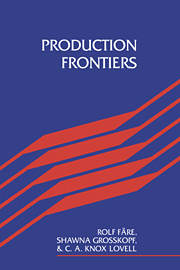Book contents
- Frontmatter
- Contents
- List of Figures
- List of Tables
- Preface
- 1 Introduction
- 2 Production Technology
- 3 Input-Based Efficiency Measurement
- 4 Output-Based Efficiency Measurement
- 5 Indirect Input-Based Efficiency Measurement
- 6 Indirect Output-Based Efficiency Measurement
- 7 The Measurement of Price Efficiency
- 8 Graph Efficiency Measurement
- 9 Efficiency Measurement and Productivity Measurement
- 10 Topics in Efficiency Measurement
- A Standard Notations and Mathematical Appendix
- References
- Biographical Index
- Index
5 - Indirect Input-Based Efficiency Measurement
Published online by Cambridge University Press: 23 October 2009
- Frontmatter
- Contents
- List of Figures
- List of Tables
- Preface
- 1 Introduction
- 2 Production Technology
- 3 Input-Based Efficiency Measurement
- 4 Output-Based Efficiency Measurement
- 5 Indirect Input-Based Efficiency Measurement
- 6 Indirect Output-Based Efficiency Measurement
- 7 The Measurement of Price Efficiency
- 8 Graph Efficiency Measurement
- 9 Efficiency Measurement and Productivity Measurement
- 10 Topics in Efficiency Measurement
- A Standard Notations and Mathematical Appendix
- References
- Biographical Index
- Index
Summary
Introduction
The purpose of this chapter is to extend the radial input-based efficiency measures in Chapter 3, where efficiency of the observed input vector is judged relative to technology, given fixed outputs, to the case in which input efficiency is judged relative to the revenue indirect production technology. In this case, outputs are restricted but not fixed, and they may vary as long as their revenue meets or exceeds a prespecified target. In contrast, in Chapter 3 outputs are assumed exogenously fixed.
In Section 5.1, price-independent measures of indirect input-based technical efficiency are developed. These measures take output prices and target revenue as given and measure efficiency as proportional contraction of all inputs. The measures distinguish between scale, congestion and purely technical efficiency. Complete decomposition of the constant returns, strong disposal revenue indirect measure of technical efficiency is provided. All our technical measures are radial in nature, but it is clear that nonradial measures like the Russell measure introduced in Chapter 3 may also be considered. We leave this for the interested reader.
Price dependent input-based measures are discussed in Section 5.2. We introduce input prices and consider the objective of shrinking expenditure on input. This leads to revenue indirect measures of input cost efficiency and input allocative efficiency which, together with one of our technical measures, yields a decomposition of revenue indirect cost efficiency.
In Section 5.3 we discuss measures of benefit effectiveness by comparing the minimum cost with the target revenue it generates. In Section 5.4 comparisons between direct and indirect measures are discussed.
- Type
- Chapter
- Information
- Production Frontiers , pp. 128 - 152Publisher: Cambridge University PressPrint publication year: 1993



